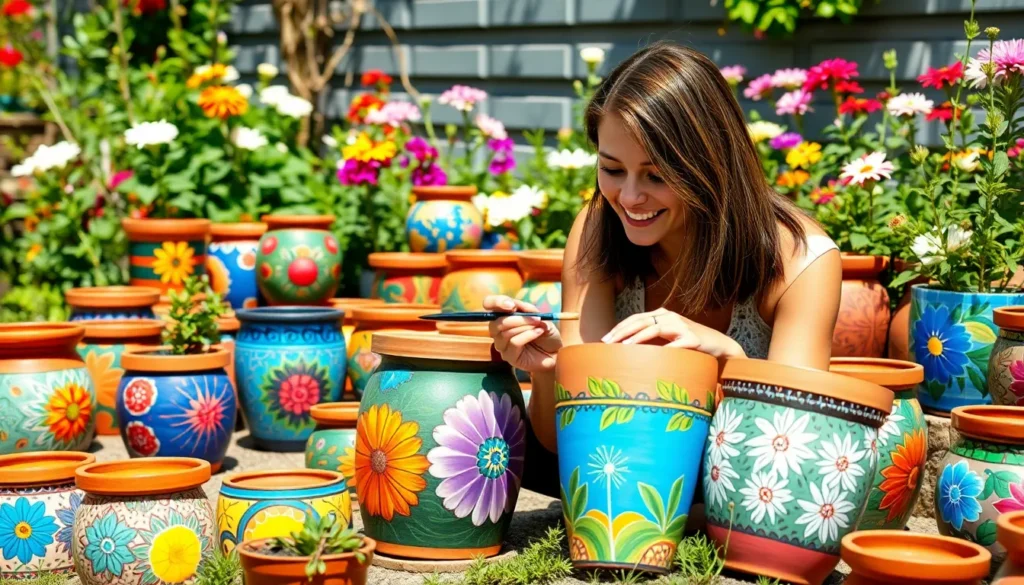Transform your plain terracotta pots into stunning decorative masterpieces with creative painting techniques that’ll breathe new life into your garden or home décor. Whether you’re a seasoned crafter or just starting your artistic journey, we’ve discovered countless ways to turn ordinary clay pots into extraordinary statement pieces that reflect your personal style.
We’ll explore everything from simple geometric patterns and ombré effects to intricate mandala designs and seasonal themes that’ll make your planters the envy of every neighbor. These budget-friendly projects require minimal supplies but deliver maximum impact, proving that you don’t need expensive materials to create beautiful results.
Ready to unleash your creativity and give your plants the stylish homes they deserve? We’re about to share our favorite painting techniques, color combinations, and design inspirations that’ll help you create one-of-a-kind pottery that’s both functional and fabulous.
Creative Color Schemes for Your Painted Pots
Choosing the right color scheme transforms ordinary pots into stunning focal points that complement your space and showcase your plants beautifully.
Monochromatic Elegance
Sophisticated blues create a calming atmosphere when we layer different shades from navy to powder blue on our terracotta pots. Start with the darkest shade as your base color and gradually blend lighter tones toward the rim for a professional ombré effect. Deep forest greens work exceptionally well for this technique, especially when we add subtle white highlights to create dimension.
Classic black and white combinations never go out of style and pair perfectly with any decor. We recommend using matte black paint as your primary color and adding white geometric patterns, dots, or brush strokes for visual interest. Charcoal grays mixed with crisp whites offer a modern alternative that’s both elegant and versatile.
Rich burgundy tones bring warmth to any garden space while maintaining that sophisticated monochromatic appeal. Layer wine red, burgundy, and deep rose shades to create depth and texture on your painted pots.
Bold Contrast Combinations
Turquoise and coral create an energetic tropical vibe that’s perfect for summer gardens and patio displays. We love painting the base in bright turquoise and adding coral accent stripes, polka dots, or floral motifs around the rim. This combination works particularly well with succulents and flowering plants.
Electric yellow paired with deep purple makes a striking statement that catches attention from across the garden. Paint alternating sections in each color or create a sunset effect by blending these complementary shades together. Navy blue and bright orange offer another ever-changing contrast option that’s both modern and playful.
Hot pink and lime green bring tropical paradise energy to your pot painting projects. We suggest using hot pink as your dominant color and adding lime green geometric patterns, leaves, or abstract designs for maximum visual impact.
Pastel Garden Themes
Soft lavender and mint green combinations evoke peaceful cottage garden vibes that complement herbs and delicate flowering plants perfectly. We recommend painting the entire pot in lavender and adding mint green details like small flowers, vines, or decorative borders. Rose quartz pink paired with sage green creates a similar calming effect.
Peachy coral with cream accents brings warmth to shaded garden areas while maintaining that gentle pastel aesthetic. Paint your pot in soft peach and use cream colored paint to add polka dots, stripes, or delicate botanical patterns around the surface.
Baby blue and buttery yellow create cheerful spring themes that work beautifully with small flowering plants and herbs. We love alternating these colors in wide horizontal stripes or painting the pot blue with yellow daisy patterns scattered across the surface.
Geometric Patterns and Designs for Modern Pot Painting
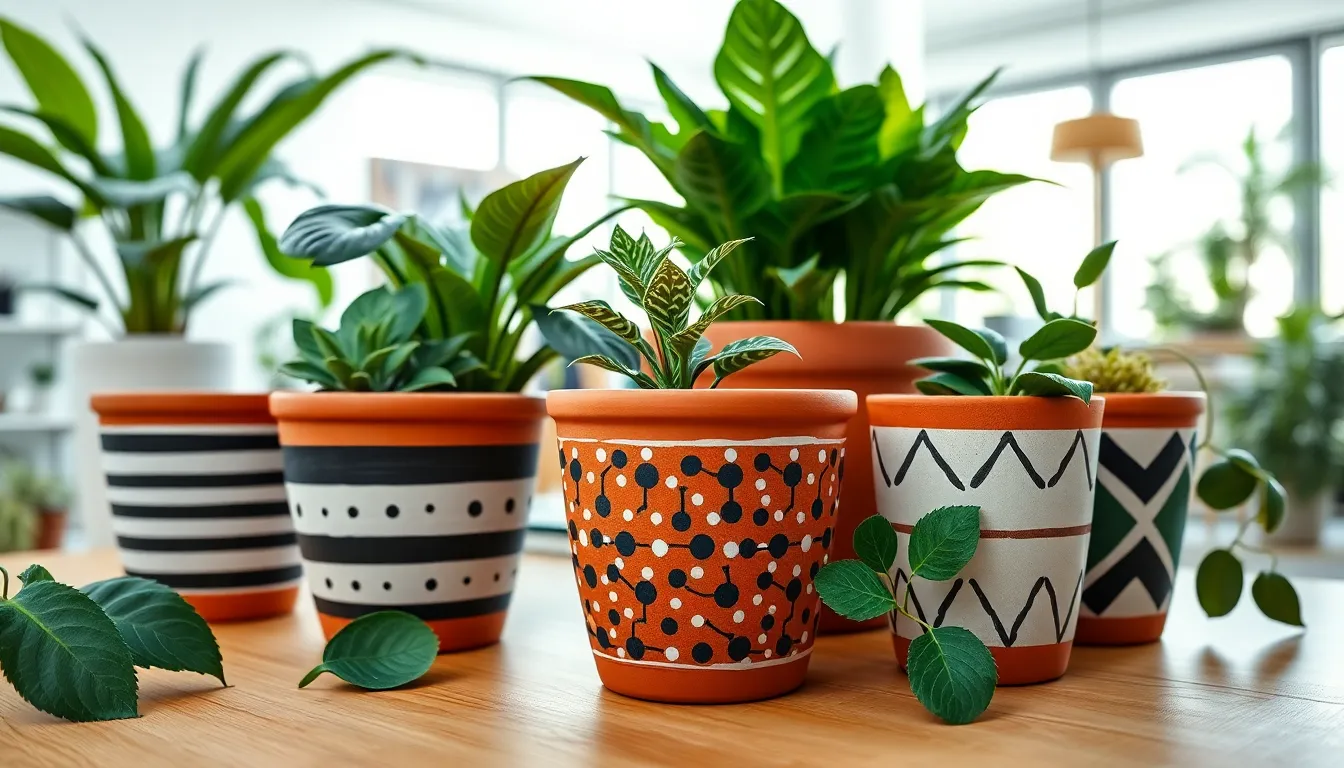
Geometric patterns offer a contemporary approach to pot painting that complements modern interior design styles. We’ll explore several versatile geometric techniques that transform ordinary pots into sophisticated decorative pieces.
Stripes and Lines
Stripes create instant visual impact while remaining surprisingly simple to execute. We recommend starting with chevron stripes, which add ever-changing movement to your pot design and work beautifully with both neutral and bold color palettes. Horizontal lines offer a calming, grounded feel that pairs perfectly with tall, architectural plants like snake plants or fiddle leaf figs.
Vertical stripes elongate shorter pots and create the illusion of height in your arrangements. We’ve found that varying line thickness adds depth and prevents the design from appearing too uniform or mechanical. Tape serves as your best friend when creating crisp, clean lines that maintain professional quality results.
Polka Dots and Circles
Polka dots bring playful energy to modern pot designs without sacrificing sophistication. We suggest using contrasting colors to make dots pop against the base color, creating visual interest that draws attention to your plants. Circular patterns extend beyond simple dots to include mandala inspired designs that radiate from the pot’s center.
Graduated dot sizes create ever-changing movement across the pot surface, while uniform dots maintain clean, minimalist appeal. We’ve discovered that metallic dots in gold or copper add luxury touches that elevate simple terracotta pots to designer status. Circle stencils ensure consistent sizing and spacing for professional looking results.
Triangle and Diamond Motifs
Triangles and diamonds introduce angular sophistication that perfectly complements modern geometric decor. We particularly love painting these shapes in metallic finishes like gold or silver, which creates luxurious contrast against matte base colors. Diamond patterns arranged in repeating sequences establish rhythm and visual flow around the pot’s circumference.
Asymmetrical triangle arrangements break traditional pattern rules while maintaining modern appeal. We use painter’s tape to define sharp, clean edges before applying paint, ensuring crisp geometric precision. Overlapping diamond motifs create depth and complexity that transforms simple shapes into intricate artistic statements worthy of any contemporary space.
Nature-Inspired Painting Pots Ideas

Drawing inspiration from the natural industry creates stunning decorative pieces that seamlessly blend with garden environments. We’ll explore organic motifs that transform ordinary containers into artistic masterpieces celebrating nature’s beauty.
Floral and Botanical Designs
Vibrant flower patterns bring gardens directly onto our containers with bold blooms and delicate petals. Paint roses, daisies, or sunflowers using acrylics for long-lasting color that won’t fade in outdoor conditions.
Watercolor floral techniques create soft, dreamy effects using diluted paints and blending methods. Apply wet-on-wet techniques to achieve natural color bleeding that mimics real flower gradations.
Botanical illustration styles showcase detailed plant studies with scientific accuracy and artistic flair. Sketch ferns, leaves, or herb sprigs first, then fill with natural greens and earth tones for authentic results.
Pressed flower decoupage combines real botanical elements with paint for textured surfaces. Layer actual dried flowers between paint coats, sealing with outdoor varnish for weather protection.
Animal and Wildlife Themes
Colorful butterfly motifs add whimsical movement to container gardens with painted monarch, swallowtail, or blue morpho designs. Use bright oranges, blues, and yellows to capture their natural vibrancy against neutral pot backgrounds.
Wildlife habitat scenes depict animals in natural settings like forest clearings or meadow landscapes. Paint deer silhouettes against sunset backgrounds or rabbits among wildflower patches for storytelling elements.
Bird pattern collections feature cardinals, hummingbirds, or owls using detailed brushwork and realistic color schemes. Focus on distinctive markings like red cardinal crests or owl eye patterns for recognition.
Insect garden themes celebrate beneficial creatures like ladybugs, bees, and dragonflies essential for plant health. Use metallic paints for dragonfly wings and bright reds for ladybug shells.
Industry and Scenic Patterns
Alpine mountainscape art captures serene peaks and valleys using layered painting techniques and cool color palettes. Paint distant mountains in pale blues and purples, adding snow caps with white highlights for depth.
Ocean wave seascapes bring coastal energy to garden spaces with flowing blue and green gradients. Use curved brushstrokes to create wave motion and add white foam caps for realistic water movement.
Stellar night sky designs transform containers into cosmic art pieces with deep blues, purples, and metallic star accents. Apply dark base coats first, then add constellation patterns using silver or gold paint pens.
Desert sunset scenes showcase warm amber, orange, and pink hues reflecting southwestern landscapes. Paint layered mountain silhouettes against gradient skies for dramatic evening effects.
Textured Painting Techniques for Unique Pot Finishes
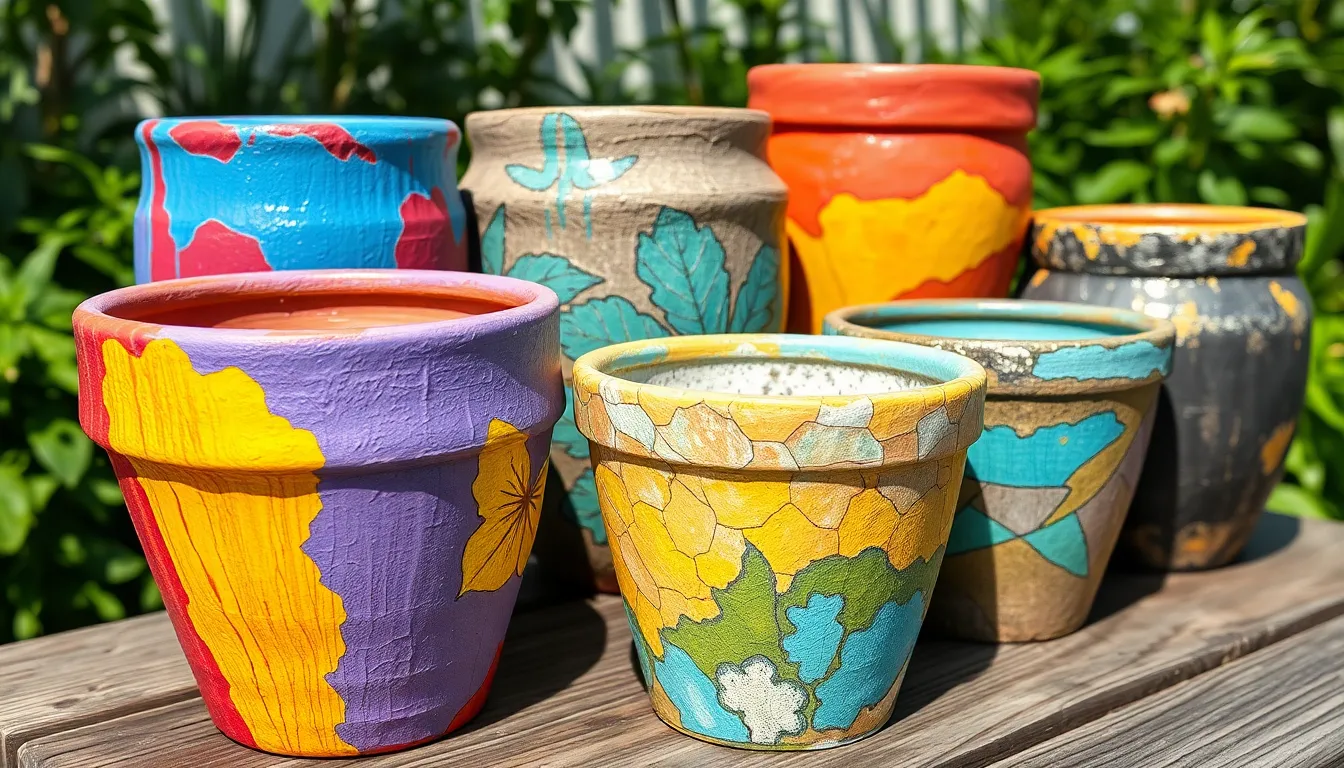
We’ll explore advanced painting methods that add dimensional depth and tactile interest to your pot projects. These techniques transform flat surfaces into visually captivating pieces that engage multiple senses.
Sponge Painting Methods
Sponge painting creates organic texture patterns that mimic natural surfaces like stone or coral. We recommend using natural sea sponges rather than synthetic ones since they produce more authentic irregular patterns. Dab the sponge lightly into your paint without oversaturating it to achieve the best results.
Layer different colors by allowing each sponge application to dry completely before adding the next shade. Start with lighter base colors and gradually build up darker tones for realistic depth. We’ve found that metallic paints work exceptionally well with sponge techniques, creating shimmering surfaces that catch light beautifully.
Apply paint in a gentle dabbing motion rather than wiping to preserve the sponge’s natural texture imprint. Rotate the sponge frequently to avoid repetitive patterns that look artificial. This method works particularly well for creating faux marble effects or weathered stone appearances on terracotta surfaces.
Crackle and Distressed Effects
Crackle glazes produce authentic aged appearances through controlled surface cracking as the medium dries and shrinks. We apply a base coat first, then brush on the crackle medium while the base is still slightly tacky for optimal adhesion. The thickness of your crackle application determines the size of the resulting cracks.
Sand lightly between coats to enhance the distressed look and reveal underlying paint layers. Focus on edges and raised areas where natural wear would typically occur. We often use contrasting colors between layers to make the cracking effect more dramatic and visible.
Create additional distressing by scraping with palette knives or wire brushes while the paint is semi-dry. This technique mimics years of weathering and outdoor exposure. Apply dark antiquing glazes into the cracks to emphasize the aged effect and add authentic character to your finished pieces.
Metallic and Shimmer Accents
Metallic glazes transform ordinary pots into luxurious statement pieces with reflective surfaces that change appearance throughout the day. We apply these glazes over textured base coats to create depth and visual interest. Bronze, copper, and gold tones work particularly well with earthy terracotta colors.
Shimmer effects using mica-based glazes add subtle sparkle without overwhelming the overall design. These materials catch and reflect light differently than traditional metallics, creating a more delicate luminous quality. We recommend applying shimmer glazes as final topcoats to preserve their reflective properties.
Build up metallic effects gradually through multiple thin applications rather than single heavy coats. This approach prevents dripping and ensures even coverage across textured surfaces. Dry brush techniques work exceptionally well for highlighting raised areas while leaving recessed portions darker for enhanced dimensionality.
Seasonal Painting Pots Ideas for Year-Round Appeal

We’ve explored advanced techniques and dimensional effects, and now we’ll discover how seasonal themes can keep your painted pots fresh and relevant throughout the year.
Spring and Summer Bright Colors
Floral patterns capture spring’s essence perfectly when painted on terracotta surfaces with vibrant blooms and delicate petals. We recommend using bright pinks, sunny yellows, and fresh greens to mirror the season’s natural awakening. Sea-inspired themes work beautifully for summer projects, incorporating coastal blues and crisp whites that evoke beachside tranquility and ocean breezes.
Moss-covered designs add natural texture to spring containers by layering earthy greens and botanical elements. These organic patterns complement fresh plantings while maintaining that just-sprouted garden aesthetic. Rubber band techniques create perfectly spaced stripes when wrapped around pots before painting, ensuring clean lines and professional-looking results.
Fall Harvest and Autumn Tones
Pumpkin motifs celebrate autumn’s bounty when painted in rich oranges and deep golds alongside scattered leaf designs. We love incorporating maple leaves, acorns, and harvest vines to capture fall’s natural abundance. Golden hues paired with burnt oranges create warmth that mirrors autumn foliage and complement seasonal plantings like mums and ornamental kale.
Distressed techniques work exceptionally well for fall designs, aging your terracotta pots to match the season’s rustic charm. These weathered effects enhance the harvest theme while creating containers that look naturally aged by seasons of garden use.
Winter Holiday and Festive Designs
Snowflake patterns transform ceramic pots into winter wonderlands when painted in silver and white against deep blue or forest green backgrounds. We suggest adding delicate crystalline details that catch light and create magical sparkle effects. Snowmen designs bring whimsical charm to winter containers with their cheerful faces and colorful scarves painted in traditional holiday colors.
Holiday icons like Christmas trees, holly leaves, and festive wreaths create seasonal appeal that lasts throughout the winter months. These motifs work beautifully on both glazed and unglazed surfaces when properly primed and sealed for durability. Primer and sealant application becomes especially important for winter designs, protecting painted surfaces from harsh weather conditions while maintaining vibrant colors through the cold season.
Cultural and Artistic Styles for Pot Decoration
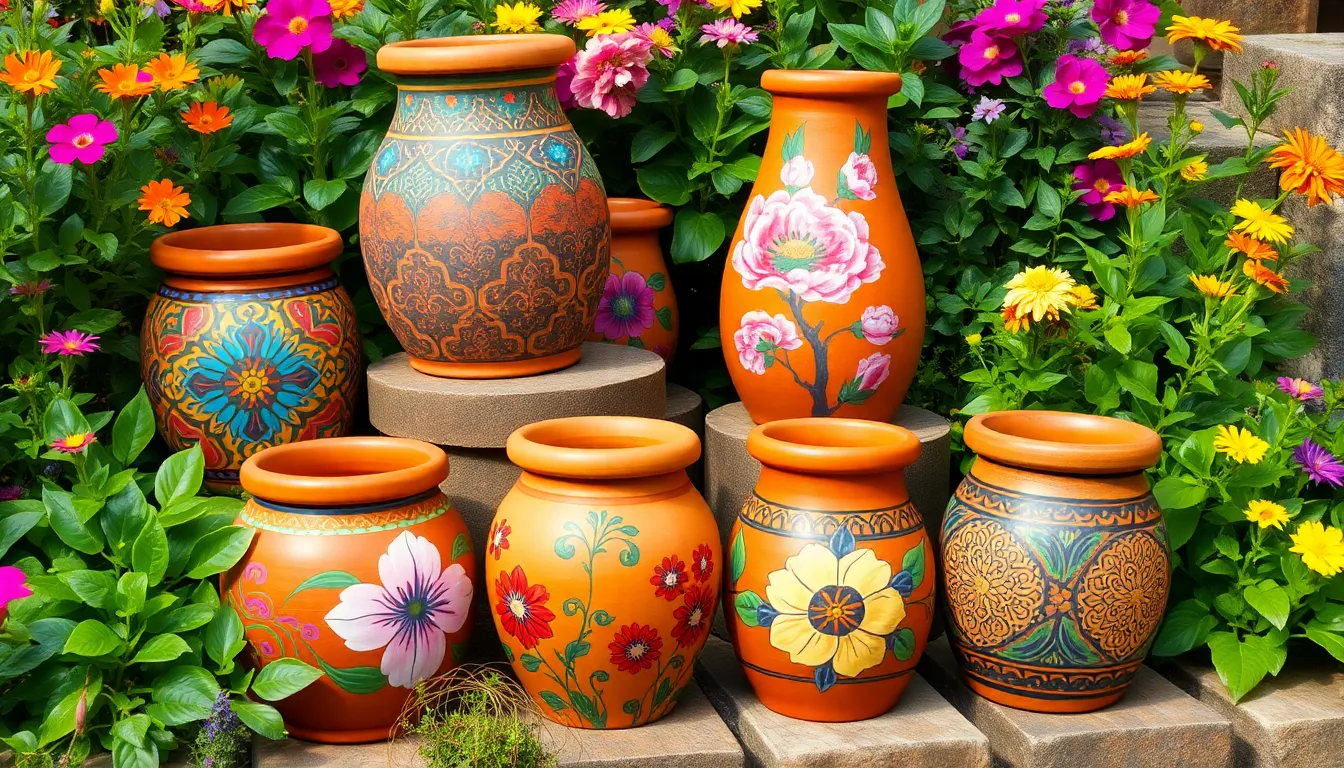
Drawing inspiration from rich cultural traditions can transform ordinary terracotta pots into stunning artistic statements. Global art movements offer endless possibilities for creating unique and meaningful decorative pieces.
Mediterranean and Moroccan Influences
Mediterranean pottery captures the vibrant essence of North African and Islamic artistic traditions through bold colors and intricate patterns. We’ve found that Moroccan-inspired designs featuring deep blues, emerald greens, and sunset oranges create stunning focal points in any garden space. Traditional zellige mosaic techniques translate beautifully to pot painting, allowing us to recreate those geometric patterns that make Moroccan architecture so captivating.
Geometric designs form the backbone of this decorative style, with patterns inspired by Islamic art creating sophisticated visual interest. We recommend incorporating gold leaf accents to elevate simple geometric shapes into luxurious statement pieces. Floral motifs intertwined with angular patterns provide the perfect balance between organic beauty and structured design elements.
Natural materials like henna-inspired browns and terracotta reds connect these painted pots to their Mediterranean origins. Complex layering techniques help us achieve the depth and richness characteristic of traditional Moroccan pottery, while simpler interpretations work beautifully for beginner artists.
Asian-Inspired Zen Patterns
Asian design philosophy emphasizes simplicity and harmony, making it perfect for creating serene garden containers. We love using minimalist bamboo motifs that capture the essence of tranquility without overwhelming the natural beauty of plants. Cherry blossom branches painted in soft pinks and whites bring delicate elegance to any outdoor space.
Nature-inspired color palettes featuring sage greens, warm beiges, and calming blues create that coveted zen atmosphere in garden settings. Single brushstroke techniques borrowed from traditional Japanese painting add authentic character to these peaceful designs. Mountains rendered in misty grays and blues can transform a simple pot into a meditation-worthy art piece.
Negative space plays a crucial role in Asian-inspired designs, where what we don’t paint becomes just as important as what we do. Balance and symmetry guide our composition choices, ensuring each painted element serves the overall harmony of the design.
Folk Art and Traditional Motifs
Folk art traditions from around the industry provide rich inspiration for creating culturally important painted pots. We’ve discovered that Berber-influenced designs using traditional coil-inspired patterns bring rustic authenticity to modern garden spaces. Hand-carved appearance techniques help us replicate the textural depth found in traditional pottery methods.
Symbolic motifs carry cultural stories and meanings, making each painted pot a conversation piece about artistic heritage. We often incorporate regional color combinations that reflect local traditions, from Scandinavian blues and whites to Mexican tierra cotta and turquoise palettes. Pennsylvania Dutch hex signs translate beautifully to circular pot designs, bringing protective symbolism to plant containers.
Engraving effects created through layered paint techniques add sophisticated texture that mimics traditional carving methods. Regional wildflower patterns connect folk art traditions to local botanical elements, creating pieces that feel both worldly and homegrown.
Kid-Friendly Painting Pots Ideas for Family Projects

Creating painted pots with children opens up wonderful opportunities for bonding while developing their artistic skills. We’ll explore captivating projects that capture precious memories and spark young imaginations.
Simple Handprint Designs
Handprint flowers transform small hands into beautiful blooms when pressed onto pottery surfaces with vibrant acrylic paint. We recommend using children’s handprints to create daisy petals around a painted center or layering multiple handprints for full sunflower designs. Handprint trees become treasured keepsakes when we add fingerprint leaves and painted bark details around the palm impression.
Footprint butterflies emerge when we place a child’s foot vertically on the pot and add colorful wing patterns with brushes. Converting footprints into adorable animals like elephants, penguins, or flamingos creates unique pottery pieces that showcase growing feet over time. Memory preservation happens naturally as we capture these small prints before children outgrow them.
Cartoon Characters and Fun Faces
Character themes featuring beloved cartoon faces like Mickey Mouse, Peppa Pig, or SpongeBob engage kids in the creative process from start to finish. We suggest starting with simple circular shapes and adding distinctive features that children can easily recognize and replicate. Interactive painting occurs when kids choose their favorite characters and work together to recreate familiar details.
Emotional faces allow children to express feelings through pottery art by painting happy smiles, surprised expressions, or sleepy eyes. Creating a set of emotion pots helps kids identify and discuss different feelings while developing fine motor skills. Silly expressions with googly eyes, rainbow tears, or monster teeth add humor and personality to each painted piece.
Educational Alphabet and Number Themes
Alphabet plates combine learning with creativity when we paint individual letters on small pottery pieces for spelling games and educational activities. Each letter can feature corresponding images like “A” with an apple or “B” with a butterfly to reinforce letter recognition. Progressive learning happens as children practice writing letters with paint brushes on curved surfaces.
Number themes transform counting lessons into artistic adventures through painted number blocks, counting dots, or mathematical symbols on pottery surfaces. We can create addition and subtraction problems using colorful numbers that children solve while admiring their artwork. Educational entertainment flourishes when learning becomes a hands-on painting experience that children remember long after the paint dries.
Advanced Techniques for Professional-Looking Results
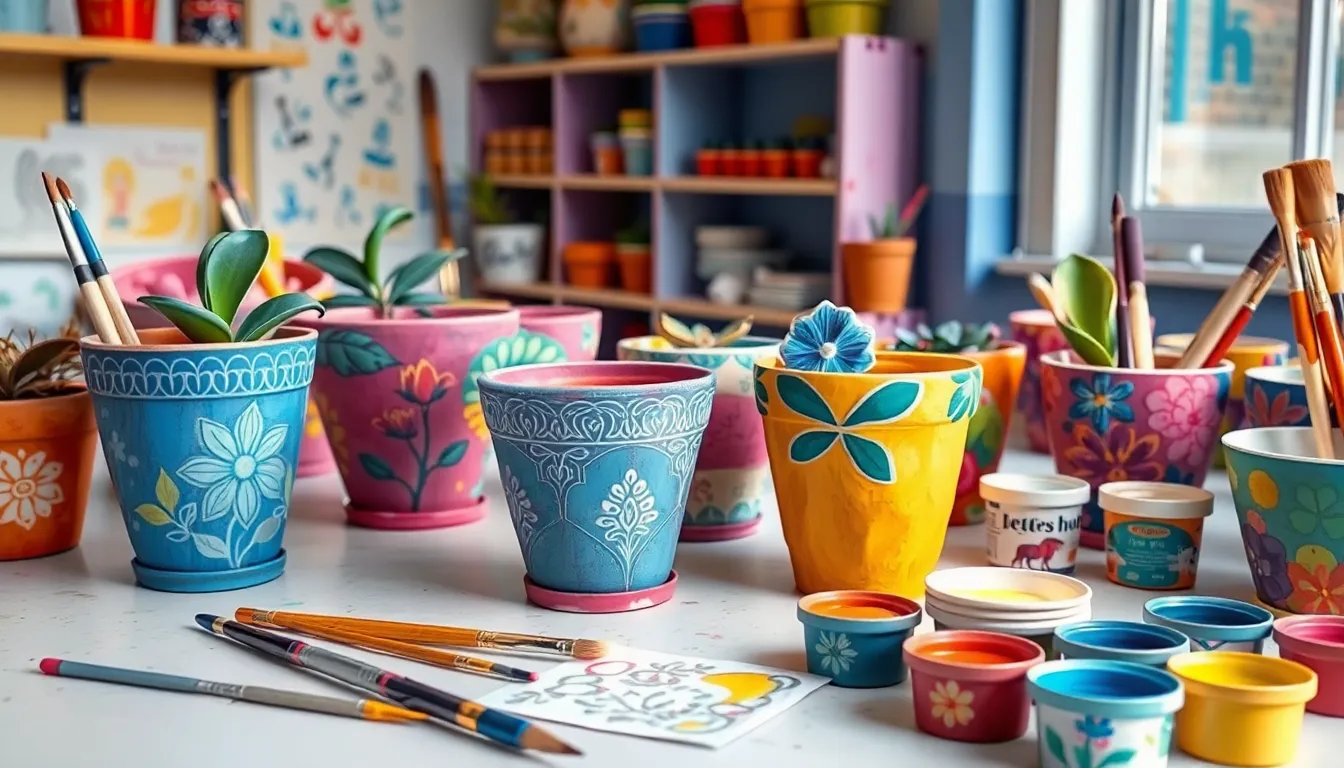
Mastering sophisticated painting techniques elevates our pot projects from simple crafts to professional-quality artwork. These advanced methods require patience and practice but deliver stunning results that rival store-bought decorative pieces.
Layering and Blending Colors
Underglazes create watercolor-like effects that transform ordinary pots into artistic masterpieces. Liquid underglazes offer painterly freedom for flowing designs while semi-moist underglaze pans provide precise control for delicate wash effects. We recommend testing small areas first to understand how different underglazes interact with our chosen pot surfaces.
Color mixing opens endless possibilities for creating custom hues that perfectly match our design vision. Combining underglaze colors requires careful testing since firing can dramatically alter the final appearance. We suggest creating sample tiles with different color combinations before committing to our main project.
Blending techniques work best when we apply colors while they’re still slightly damp. Feathering edges together creates smooth transitions that mimic professional watercolor paintings. We can achieve gradient effects by gradually lightening or darkening colors as we work across the pot’s surface.
Stenciling and Template Methods
Stencils ensure crisp, uniform designs that look professionally executed every time. They’re particularly valuable for intricate patterns like mandala details or precise text elements that would be difficult to freehand. We recommend using repositionable stencils that won’t leave residue on our painted surfaces.
Templates help us maintain consistent proportions and spacing across multiple pots or repeated design elements. Cardboard templates work well for simple shapes while plastic templates offer durability for multiple uses. We can create custom templates by tracing our desired shapes onto sturdy materials.
Pattern alignment becomes crucial when working with stencils across curved surfaces. We mark reference points on our pots before positioning stencils to ensure patterns remain level and evenly spaced. Masking tape helps secure stencils while we paint, preventing unwanted paint bleeding.
Protective Coating and Finishing Tips
Clear glaze acts as both protector and enhancer for our decorative work. Applying clear glaze over underglazes intensifies colors while creating a durable barrier against weather and handling. We typically apply glaze in thin, even coats to avoid drips or thick spots that can ruin our design.
Surface preparation determines the quality of our final finish. Ensuring our pottery is completely dry and dust-free prevents imperfections that become permanent after firing. We use tack cloths to remove any particles before applying protective coatings.
Firing considerations affect how our protective coatings perform over time. Most clear glazes require exact temperature ranges to achieve proper adhesion and durability. We consult firing charts to match our chosen glazes with appropriate kiln settings for long-lasting results.
Conclusion
We’ve explored countless ways to transform ordinary terracotta pots into stunning works of art that reflect your personal style and creativity. From simple beginner-friendly designs to sophisticated professional techniques there’s truly something for every skill level and artistic vision.
The beauty of painted pot projects lies in their versatility and accessibility. Whether you’re drawn to cultural motifs geometric patterns or nature-inspired themes you can create unique pieces that complement your home and garden perfectly.
We encourage you to start with techniques that appeal to you most and gradually experiment with more advanced methods as your confidence grows. Remember that each painted pot tells a story and becomes a meaningful addition to your space that you’ll treasure for years to come.
Frequently Asked Questions
What supplies do I need to paint terracotta pots?
You’ll need basic supplies including terracotta pots, acrylic paints, brushes of various sizes, primer, and sealant. Optional materials include painter’s tape for clean lines, natural sponges for texture, metallic paints for accents, and stencils for precise patterns. Most supplies are budget-friendly and available at craft stores.
How do I prepare terracotta pots before painting?
Clean the pot thoroughly to remove dust and debris. Apply a primer specifically designed for porous surfaces to ensure paint adhesion. Let the primer dry completely before painting. For best results, lightly sand any rough spots and wipe clean with a damp cloth.
What are some beginner-friendly painting techniques?
Start with simple techniques like solid color blocks, horizontal or vertical stripes using painter’s tape, or basic polka dots. Sponge painting creates easy organic textures, while simple geometric patterns like chevron stripes add visual interest without requiring advanced skills.
How can I create geometric patterns on pots?
Use painter’s tape to create clean lines for chevron stripes, triangles, and diamond motifs. For circles and polka dots, use stencils or household items like bottle caps as templates. Metallic accents can add luxury to geometric designs, and overlapping patterns create visual depth.
What color combinations work best for painted pots?
Monochromatic schemes using blues or greens create sophisticated elegance. Bold contrasts like turquoise and coral or electric yellow with deep purple make striking statements. Pastel combinations like lavender and mint green offer gentle garden themes, while classic black and white never goes out of style.
How do I paint nature-inspired designs?
For floral patterns, use watercolor techniques for soft effects or detailed botanical illustrations for precision. Try pressed flower decoupage by combining real botanical elements with paint. Animal themes like butterflies and birds add whimsy, while landscape scenes like mountainscapes or ocean waves create dramatic focal points.
What advanced techniques can add texture to my pots?
Sponge painting with natural sea sponges creates organic textures. Crackle effects achieve an aged appearance through controlled surface cracking. Layering and blending underglazes creates watercolor-like effects. Distressed techniques using sandpaper add rustic charm, while metallic accents provide dimensional interest.
How can I make seasonal pot designs?
Spring designs feature vibrant florals in pinks and yellows. Summer themes use coastal blues and sea-inspired motifs. Fall pots showcase pumpkin designs and warm autumn tones. Winter decorations include snowflakes and holiday icons. Use rubber band spacing for seasonal stripes and distressed effects for rustic charm.
Are there kid-friendly pot painting ideas?
Yes! Simple handprint designs can be transformed into flowers or animals. Cartoon character themes engage children while allowing creative expression. Educational designs incorporating letters and numbers combine learning with art. These family projects create cherished keepsakes while developing artistic skills in children.
How do I ensure my painted pots are durable?
Use high-quality primer and acrylic paints designed for outdoor use. Apply multiple thin coats rather than one thick layer. Seal finished designs with clear protective coating or glaze. Consider firing requirements for permanent results, and store pots indoors during harsh weather conditions.

